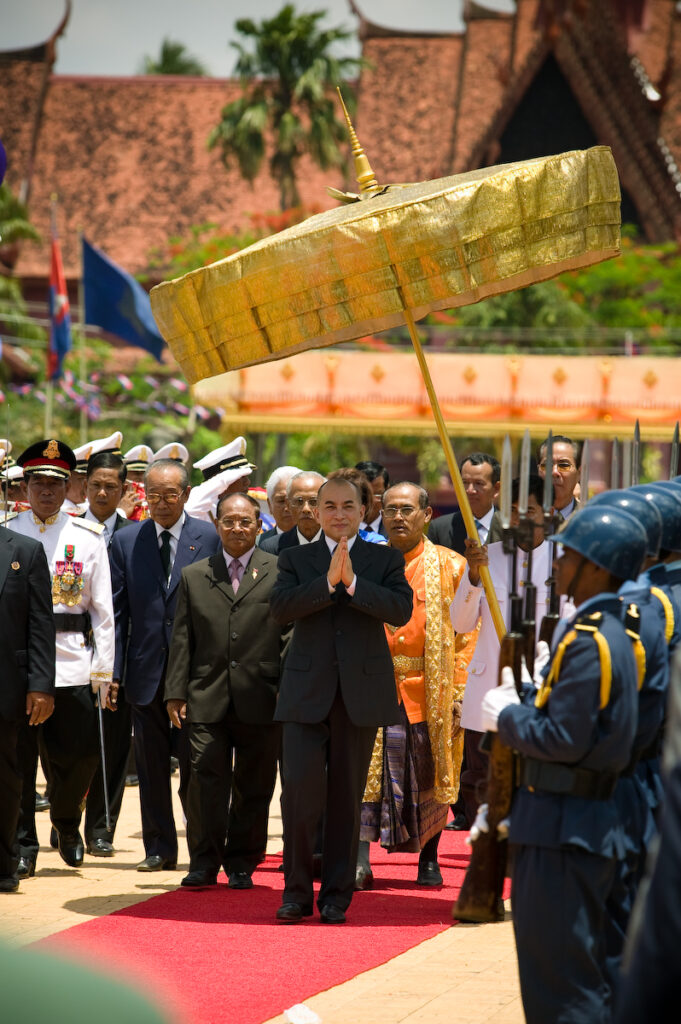Cambodia is set up as a multi-party democracy under a constitutional monarchy. The King serves as the head of state and the Prime Minister is the head of the Royal Government of Cambodia. Norodom Sihamoni,1 the King, was crowned in 2004 after the abdication of his father Norodom Sihanouk.2 Hun Sen3 has been the Prime Minister since 1985.

His Majesty, King Norodom Sihamoni of the Kingdom of Cambodia at the Royal Ploughing Ceremony in Phnom Penh. Photo by Jeffdkennel, taken on 23 May 2008. Licensed under CC BY-SA 3.0.
Cambodia adopted this form of government in 1993, following the Paris Peace Accords.4 The table below shows the various political regimes in Cambodia over the past 150 years.
| 1993-present | Kingdom of Cambodia | Constitutional Monarchy following Paris Peace Accords |
| 1991-1993 | State of Kampuchea | United Nations Transitional Authority in Cambodia (UNTAC) |
| 1989-1991 | Republic of Kampuchea | Government of the State of Cambodia (SOC) |
| 1979-1989 | People’s Republic of Kampuchea | Following Vietnamese occupation |
| 1975-1979 | Democratic Kampuchea | Khmer Rouge era |
| 1970-1975 | Khmer Republic | Civil war following military coup by Lon Nol |
| 1953-1970 | Kingdom of Kampuchea | The administration of Norodom Sihanouk |
| 1941-1945 | Japanese occupation | During World War 2 |
| 1863-1953 | French Protectorate of Cambodia | Part of French Indochina |
Under the 1993 Constitution, the powers of the government are separated into three branches: the executive, the legislative and the judiciary. The Council of Ministers (also known as the Cabinet of Cambodia) heads the executive branch, which includes the Prime Minister and all the ministries. Parliament has legislative power, while the power of the judiciary is vested in the Supreme Court, the Appeals Court and the municipal/provincial courts. The Parliament (made up of the National Assembly and the Senate) is led by a president and two vice presidents, selected through an absolute majority vote of assembly members before each legislative session.
According to the principle of separation of powers outlined in Art. 51 of the Constitution, each government branch should be independent to ensure that one body cannot exercise absolute control over the law. However this separation exists alongside the system of “checks and balances”—also required under the Constitution (Art. 78 and Art. 98)—which results in the executive branch having a close relationship with the parliament.
Cambodia is an indivisible state (that is, it does not share its sovereignty with any other state). While the country’s administration is divided into the capital city (which is administratively the same level as a province), provinces, districts and communes,5 the organization and functioning of provincial and local governments remain under the control of the national government. The autonomy of local administration and finance depends on the extent of decentralization and deconcentration allowed by the Cabinet of Cambodia.6 Thus, all lower levels of administration exercise authority on behalf of the national government.
Quality of governance trends
The World Bank’s Worldwide Governance Indicators (WGI) show that rankings for certain measures of Cambodia’s political governance have stayed relatively low over the past 15 years.7 The measure for ‘Political Stability and Absence of Violence/Terrorism’ is the only measure that shows significant improvement since 1996. This may be attributable to the longevity of the current ruling party and Prime Minister.
Note: The estimate of governance score ranges from approximately -2.5 (weak) to 2.5 (strong performance). WGI are a research dataset summarizing the views on the quality of governance provided by a large number of enterprise, citizen and expert survey respondents in industrial and developing countries.8 |
Decentralization
The government has a major decentralization strategy underway, largely under the National Program for Democratic Development at the Sub-national Level 2010-2019. Local government reform efforts focus on developing the operational capacity of districts and municipalities within a framework of oversight by national authorities with the capacity to enforce them.9
Up to 2018, a reported US$2.4 billion had been allocated by central government to the sub-national administrations.10 About US$152 million was given as city/district funding (from 2013 to 2018), over US$716 million as commune/Sangkat funding (from 2002 to 2018), and US$1.5 billion as capital/provincial funding (from 2009 to 2018).11
Key central government functions will be transferred to sub-national authorities, with resources (revenue, personnel, property, and management capacity), powers and duties. The ADB supports projects under a decentralization agenda to (among other goals) give rural populations greater access to public services.12
Last update on 05 June 2019
References
- 1. Royal Cabinet of the Kingdom of Cambodia. “King Norodom Sihamoni”. Accessed 17 September 2015. http://norodomsihamoni.org/en/
- 2. Royal Cabinet of the Kingdom of Cambodia. “Site officiel de SM le Roi-Père Norodom Sihanouk du Cambodge”. French language site. Accessed 17 September 2015. http://www.norodomsihanouk.info/
- 3. Cambodia New Vision. “Samdech Hun Sen”. Accessed 17 September 2015. http://cnv.org.kh/samdech-hun-sen/
- 4. The “Agreement on a comprehensive political settlement of the Cambodia conflict” was signed in Paris on 23 October 1991 by representatives from 19 nations and the United Nations to end 20 years of conflict in Cambodia. This became known as the “Paris Peace Accords”. See https://peacemaker.un.org/cambodiaparisagreement91
- 5. Constitution, article 146 new (1) (1993, as of amended in 2014).
- 6. Law on the Commune Administration. Law on the Administration of the Capital City, Province, and Districts. http://www.cdc-crdb.gov.kh/cdc/twg_network/country_systems_cambodia/strengthening_national_systems/documents_for_reform/sndd/organic_law_2008_en.pdf. Law on the Organization and Functioning of the Council of Ministers (1994 as amended in 2013).
- 7. World Bank. “Worldwide Governance Indicators”. Accessed 30 October 2018. http://info.worldbank.org/governance/wgi/index.aspx#reports
- 8. World Bank. “Worldwide Governance Indicators”. Accessed 05 June 2019. http://bit.ly/1JzSmiJ
- 9. Royal Government of Cambodia. “National Strategic Development Plan 2014-2018.” Accessed 11 September 2015. http://ncdd.gov.kh/images/National_Program/NP-SNDD%20Final%2028-05-2010%20_En_.pdf
- 10. Ministry of Information. “More Than US$2 Billion Of State Budget Allocated To Sub-National Administrations”, 24 December 2018. Accessed 27 January 2019. https://information.gov.kh/detail/252342
- 11. Ibid
- 12. Asian Development Bank. “Cambodia: Decentralized public service and financial management SP2 (decentralized rural infrastructure).” Accessed 21 October 2015. http://www.adb.org/projects/41392-023/main

